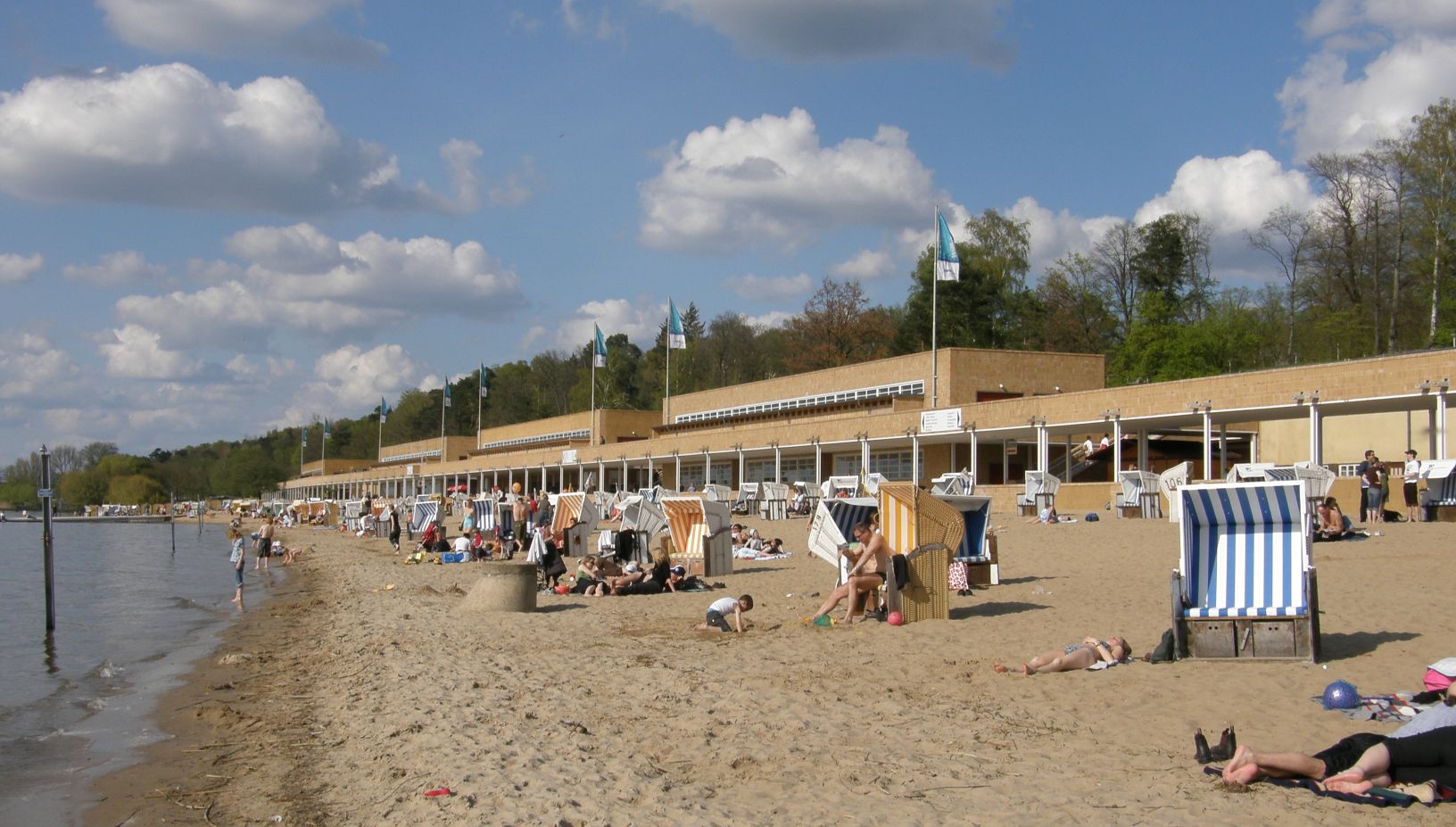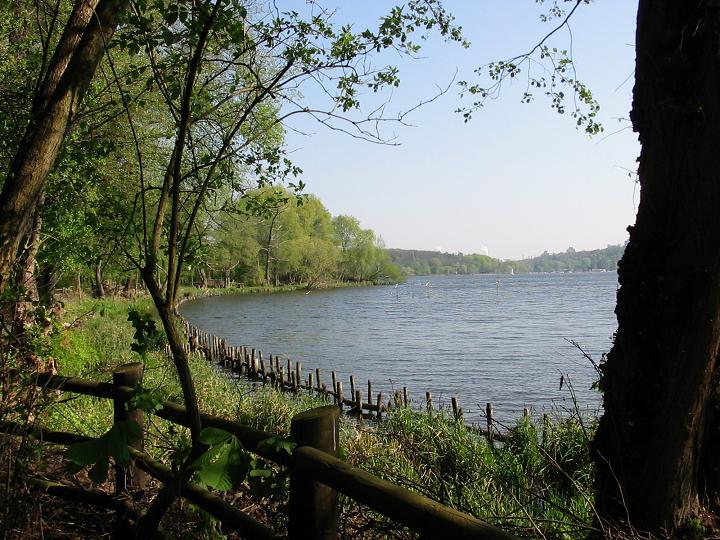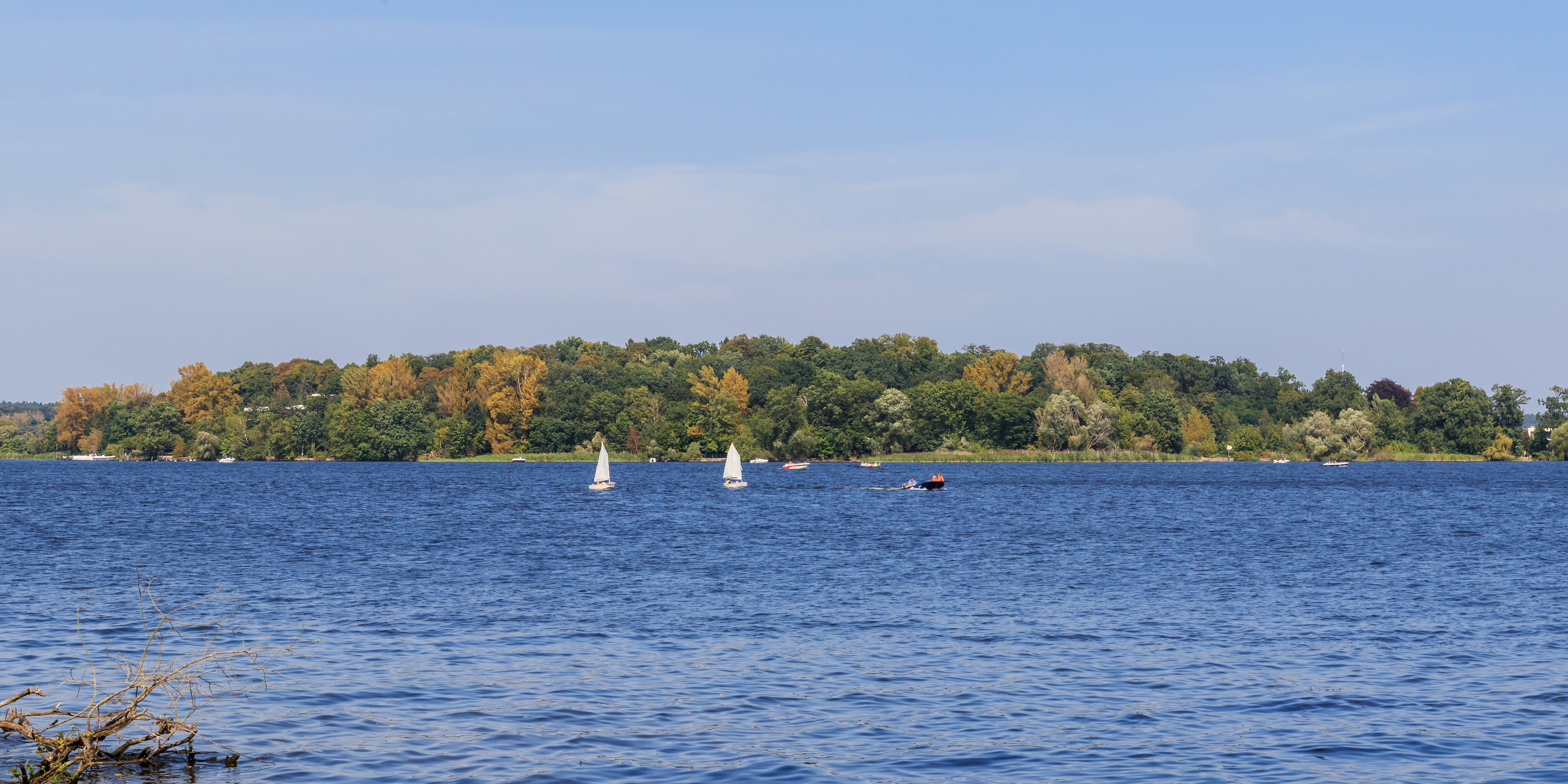|
Nikolassee
Nikolassee () is a locality (''Ortsteil'') of Berlin in the borough (''Bezirk'') of Steglitz-Zehlendorf, named after the small Nikolassee lake. Located in the affluent Southwest of the city, the area comprises parts of the Schlachtensee neighbourhood and the eastern shore of the Großer Wannsee lake with the large '' Strandbad Wannsee ''lido, as well as the islets of Schwanenwerder and Lindwerder. Geography Nikolassee is located on the Bundesstraße 1 road from the Berlin city centre to Potsdam, south of the extended Grunewald forest. The river Havel separates it from Kladow and Gatow in the Spandau borough. Other localities bordering with Nikolassee are Wannsee, Zehlendorf and Grunewald (this one in Charlottenburg-Wilmersdorf district ). Its southern neighbour Kleinmachnow is a municipality in the Potsdam-Mittelmark district of Brandenburg. The residential areas of Nikolassee and Grunewald are separated by the Grunewald forest. History Once part of the Düppel manor, fr ... [...More Info...] [...Related Items...] OR: [Wikipedia] [Google] [Baidu] |
Berlin-Nikolassee Station
station (german: Bahnhof Berlin-Nikolassee) is a railway station in the area of Berlin, Germany. It is served by trains of the , and is notable for its prominent Neo-Gothic entrance building. Overview line S1 operates to and from central Berlin via the ' and terminates one station down the line at . Line S7 operates to and from central Berlin via the ', and passes through Wannsee on its route to '. The two lines are served by separate island platforms on different alignments, with the S1 platform at a lower level than the S7 platform. A pair of main line tracks run parallel to the S7, but trains on these lines do not stop at , and no platforms are provided. The two platforms are linked to each other, and to the station building, by walkways. A flying junction to the west of the station keeps the main line segregated from the lines. The same flying junction brings the two lines together, with the S1 lines between the S7 lines so as to allow cross-platform interchange A ... [...More Info...] [...Related Items...] OR: [Wikipedia] [Google] [Baidu] |
Strandbad Wannsee
The Strandbad Wannsee is an open-air lido on the eastern shore of Großer Wannsee lake, a large bay of the Havel river in Berlin, Germany. Opened in 1907, it is one of the largest inland lidos in Europe, with a beach that is long and wide, replenished with sand from the Baltic coast. The entire ensemble of long, low buildings that appear to grow out of the underlying sandhills were designed by Richard Ermisch and fellow architect Martin Wagner in 1929–1930; it is today placed under monumental protection. Location The area is part of the Nikolassee locality (not of Wannsee), in the Steglitz-Zehlendorf borough, in southwestern Berlin. The lido stretches along the northern section of the lake's east bank, at the eastern end of the ''Breite'', the broad stretch of the Havel between Kladow and Wannsee, close to Schwanenwerder island. Strandbad Wannsee is run as a municipal swimming bath by the City of Berlin. The premises cover about 355,000 m², 130,000 of which is water, and ... [...More Info...] [...Related Items...] OR: [Wikipedia] [Google] [Baidu] |
Wannsee Railway
The Wannsee Railway (german: Wannseebahn) is a suburban railway in Berlin running from Potsdamer Platz via the Ring line station of Schöneberg to Wannsee station on Großer Wannsee, a lake after which it is named. Today it is a section of the Berlin S-Bahn line S1. History Beginnings The original section of the Wannsee Railway was built in 1874 and branched off at Zehlendorf from the Potsdam trunk line and rejoined the line at the current Griebnitzsee station. After the opening of the Lichterfelde West station on the trunk line in 1872 to serve the new suburb of mansions only (''villa colony'', German: ''Villenkolonie'') of Lichterfelde-West, the new emerging suburbs of Schlachtensee, Wannsee and Düppel sought their own rail connection. The official opening of the extension was made on 1 June 1874. Unlike the new Lichterfelde West station, which was completely financed by the builder of the villa colony, Johann Anton Wilhelm von Carstenn, the planning and constructi ... [...More Info...] [...Related Items...] OR: [Wikipedia] [Google] [Baidu] |
Steglitz-Zehlendorf
Steglitz-Zehlendorf () is the sixth borough of Berlin, formed in Berlin's 2001 administrative reform by merging the former boroughs of Steglitz and Zehlendorf. Home to Free University of Berlin, the Berlin Botanical Garden, and a variety of museums and art collections, Steglitz-Zehlendorf is an important hub for research, science and culture in Berlin. It is known to be the wealthiest borough of Berlin, having the city's highest median household income. History The first mention of a present-day locality in the district by name was Lankwitz (Lancewitz) in 1239. It is assumed that Slavic and German settlements were established at the Schlachtensee and Krume Lanke lakes after 1200 at the latest. The first documented mention of Zehlendorf (then Cedelendorp) dates back to 1242. Here the Lehnin Abbey bought the settlement and kept it until 1542. Frederick the Great donated a church to the village in 1768 during a stopover on the journey from the Berlin Palace to the Sanssouci P ... [...More Info...] [...Related Items...] OR: [Wikipedia] [Google] [Baidu] |
Grunewald (forest)
Grunewald () is a German forest located in the western side of Berlin on the east side of the Havel, mainly in the Grunewald locality. At it is the largest green area in the city of Berlin. Geography The forest occupies, on the western side, 3/4 of the Grunewald locality, a small portion of the southern part of Westend (both in the Charlottenburg-Wilmersdorf borough); a great part of Nikolassee, the northern side of Zehlendorf and the northwestern part of Dahlem (all 3 in the Steglitz-Zehlendorf borough). It is close to the border of the neighborhood of Wannsee and its lake, and is near the Düppel forest. It is divided by the Havel river from the localities of Kladow, Gatow and Wilhelmstadt (all in the Spandau borough). It also borders the locality of Schmargendorf. There are twenty three islets located by the Havel ( Lindwerder and Schwanenwerder) and a small peninsula ( Schildhorn); and the tallest point is the hill of Teufelsberg, which is above sea level. On the ... [...More Info...] [...Related Items...] OR: [Wikipedia] [Google] [Baidu] |
Berlin-Blankenheim Railway
The Berlin-Blankenheim railway or Wetzlarer Bahn ("Wetzlar Railway") is a railway line in the German states of Berlin, Brandenburg and Saxony-Anhalt. It is a section of the Kanonenbahn (''Cannons Railway'') between Berlin and Metz, built between 1877 and 1882. Wetzlar used to be an important rail junction on the ''Kanonenbahn''. The Berlin-Blankenheim line originally ran from Berlin, via Bad Belzig, Güsten, Sandersleben to Blankenheim, where a remnant of it still joins the Halle–Kassel line. The Wiesenburg–Güsten section has carried no traffic since 2004 and is now closed. Only the Berlin–Wiesenburg section is electrified. The Sandersleben–Blankenheim section has only a single track, while the remainder of the still-operating parts of the line is duplicated. History The track was built at the instigation of the Prussian government between 1877 and 1882 as a direct militarily strategic railway, bypassing urban areas, connecting to Alsace-Lorraine, which had been ac ... [...More Info...] [...Related Items...] OR: [Wikipedia] [Google] [Baidu] |
Großer Wannsee
The Großer Wannsee (, "Greater Wannsee", "See" means lake) is a bight of the Havel river near the locality of Wannsee and Nikolassee (in the borough of Steglitz-Zehlendorf), a south-western suburb of the German capital Berlin not far from Potsdam. Between the river itself and the Wannsee lies the ''Breite'', or ''Grosse Breite'' (Broad, or Great Broad). To the north lies the island of Schwanenwerder and, opposite from the Greater Wannsee on the other side of the Havel, is the locality of Kladow (in Spandau). Overview The Wannsee lake is well known as the number-one bathing and recreation spot for western Berlin, especially from a 1951 Schlager hit by teen idol Cornelia Froboess. The '' Strandbad Wannsee'', an open-air lido with one of the longest inland beaches in Europe and a popular nudist area, was built in 1920–30 after a concept by architect Richard Ermisch. [...More Info...] [...Related Items...] OR: [Wikipedia] [Google] [Baidu] |
Grunewald (locality)
Grunewald () is a locality (''Ortsteil'') within the Berlin borough (''Bezirk'') of Charlottenburg-Wilmersdorf. Famous for the homonymous forest, until 2001 administrative reform it was part of the former district of Wilmersdorf. Next to Lichterfelde West, Dahlem and Westend, it is part of the affluent Berlin "Villenbogen", a row of 19th century suburbs completely made up of mansions. Geography The locality is situated in the western side of the city and is separated from Spandau by the river Havel. It borders with the localities of Westend, Halensee, Schmargendorf, Wilhelmstadt, Gatow (both in Spandau district), Nikolassee, Zehlendorf and Dahlem (all three in Steglitz-Zehlendorf district). The Grunewald forest is 10 km away from Berlin-Mitte (Germany's capital). History Etymology The name derives from the Grunewald hunting lodge of 1543, the oldest preserved castle in Berlin, which is, however, officially located within the adjacent Dahlem locality. It was erected i ... [...More Info...] [...Related Items...] OR: [Wikipedia] [Google] [Baidu] |
Zehlendorf (Berlin)
Zehlendorf () is a locality within the borough of Steglitz-Zehlendorf in Berlin. Before Berlin's 2001 administrative reform Zehlendorf was a borough in its own right, consisting of the locality of Zehlendorf as well as Wannsee, Nikolassee and Dahlem. Zehlendorf contains some of the most remarked upon natural settings in Berlin, including parts of the Grunewald forest and the ''Schlachtensee'', ''Krumme Lanke'' and ''Waldsee'' lakes. Additionally, it has large affluent residential neighborhoods, some with cobblestone streets and buildings that are over 100 years old. History The village of Zehlendorf was first mentioned as ''Cedelendorp'' in a 1245 contract between the Margraves John I and Otto III of Brandenburg and the Lehnin Abbey. Probably a German foundation, the name ''Cedelen'' appears to be a dialect word for "settlement" (modern German ), or "noble" (''Cedelendorp'' = ''Cedelen'' + ''dorp'', "noble village" (see ). In the affluent and well-educated environment of Zehlend ... [...More Info...] [...Related Items...] OR: [Wikipedia] [Google] [Baidu] |
Boroughs And Neighborhoods Of Berlin
Berlin is both a city and one of Germany’s States of Germany, federated states (city state). Since the 2001 administrative reform, it has been made up of twelve districts (german: Bezirke, ), each with its own administrative body. However, unlike the municipalities and counties of other German states, the Berlin districts are not territorial corporations of public law () with autonomous competencies and property, but simple administrative agencies of Berlin's state and city government, the City of Berlin forming a single municipality () since the Greater Berlin Act, Greater Berlin Act of 1920. Thus they cannot be equated to US or UK boroughs in the traditional meaning of the term. Each district possesses a district representatives' assembly () directly elected by proportional representation and an administrative body called district board (). The district board, comprising since October 2021 six (until then five) members - a district mayor () as head and five (earlier four) dist ... [...More Info...] [...Related Items...] OR: [Wikipedia] [Google] [Baidu] |
Wannsee
Wannsee () is a locality in the southwestern Berlin borough of Steglitz-Zehlendorf, Germany. It is the westernmost locality of Berlin. In the quarter there are two lakes, the larger ''Großer Wannsee'' (Greater Wannsee, "See" means lake) and the ''Kleiner Wannsee'' (Little Wannsee), located on the River Havel and separated only by the Wannsee Bridge. The larger of the two lakes covers an area of and has a maximum depth of . Geography Overview At the western rim of the Wannsee locality the Glienicke Bridge connects it with the city of Potsdam. The late neoclassical Glienicke Palace as well as the Pfaueninsel are nearby. Since 1990 these palaces and parks have formed part of the Palaces and Parks of Potsdam and Berlin UNESCO World Heritage Site. The locality is centred on the ancient village of Stolpe, known to exist in 1299. The locality also includes the districts of Kohlhasenbrück (named after the 1811 novella '' Michael Kohlhaas'' by Heinrich von Kleist) and Steinstücken ... [...More Info...] [...Related Items...] OR: [Wikipedia] [Google] [Baidu] |
Schwanenwerder
Schwanenwerder (; English: "Swan Ait") is an island in the locality of Nikolassee in southwestern Berlin, located in a wider stretch of the Havel close to the eastern bank and adjacent to the Großer Wannsee to the south of it. The neighbourhood is considered an affluent residential area and was home to known people such as Alexander Parvus, Joseph Goebbels, Gustav Fröhlich, Ernst Udet, and Axel Springer. History The river island, with an area of about , was first mentioned as ''Der Sandtwerder'' ("Sand Ait") in 1704. Also called ''Cladower Sandwerder'' after the opposite village of Kladow, the island in the mid 19th century was a deserted place, overgrown with shrubs and a few trees. In 1882, the island was purchased by Wilhelm Wessel, a wealthy inventor and manufacturer of kerosene lamps, for a sum of 9,000 German gold mark, Marks. He ordered extensive landscaping, built an access ringroad, subdivided the area and offered the lots for sale. The intention was for wealthy buyers l ... [...More Info...] [...Related Items...] OR: [Wikipedia] [Google] [Baidu] |






